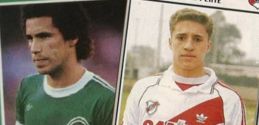A guide to the 2011 Copa America: Part One – The Minnows
The first of a six part introduction to the Copa America by David N.
Think football is over for the summer? Think again. From July 1st to the 24th, the ten nations comprising the CONMEBOL Confederation of South America, plus two guest countries, will play out the 43rd Copa America in Argentina. If you’re familiar with past tournaments, then you’ll know to expect some beautiful football, some drama, some hilariously shameless cheating, and some great spectacle, both on and off the pitch. It’s a fine showcase for South American football and for my money the most entertaining and passionate football on earth. In the UK, ESPN are screening every game, so there’s really no excuse to miss out on this occasion. I’ve put together a guide to the competitors and their prospects to aid anyone new to the fascinating world of football in Latin America, and split it into six parts. First up, the teams you probably know least about:
BOLIVIA
Traditionally one of the weakest teams in South America, Bolivia do pull off the occasional shock result at home, where playing at an altitude of 3637 metres above sea level in the Estadio Hernando Siles in La Paz gives them a significant advantage over just about any opponent from closer to sea level. In the qualifiers for the 2010 World Cup, for example, they trashed Argentina 6-1 at home but were brushed aside 3-0 in Buenos Aires. They have won the Copa America, once, in 1963, when the tournament was held in, you guessed it, Bolivia, and were runners-up in 1997 when yes, right again, it returned to Bolivia. Apart from that, they’ve made it out of the group stages only once in the last two decades, reaching the Quarter finals in 1995. More or less that same team, including Marco Etcheverry, Bolivia’s greatest player of the modern era by some distance, had qualified for the 1994 World Cup where they lost two games and drew one, scoring a single goal (against Spain in a 3-1 defeat).
The current coach, Argentine-born Gustavo Quinteros, was part of that side. He sets his team up to play on the counter, hoping to pinch goals against the strong opposition they usually face in South America, and in recent games they’ve played a 4-5-1, becoming a 4-2-3-1 in possession. The majority of the squad play their football domestically, and will be unknown to European viewers. The most notable exception to that is the big striker Marcelo Martins (above), who came to prominence with Vitoria and Cruzeiro in Brazil before a transfer to Shaktar Donesk in 2008. He hasn’t really settled in the Ukraine, however, and has had similarly pointless and unsuccessful spells on loan at Werder Bremen and Wigan Athletic. But, at his best, he is strong, pacy and leads the line well for his country, for whom he’s scored eight goals in 20 Internationals. The position as lone forward, however, may be taken by Ricardo Pedriel (left), who plays for Sivasspor in Turkey after a spell with Steau Bucharest. A recent call-up is the Naval midfielder Edivaldo, Brazilian by birth but with a Bolivian mother and spotted because he wears his nickname, “Bolivia”, on the back of his shirt for his club. He may well play behind the lone forward.
Bolivia’s problem of late has not been in attack. Their forwards and midfielders are capable, and they sporadically deliver impressive results against bigger nations, albeit generally with that altitude advantage at home. Defensively they are weak, with ageing players and little pace, and they concede goals in virtually every game. They seem particularly vulnerable to long balls played behind, and the quick strikers of Argentina and Colombia may be anticipating lots of opportunities when they face the Bolivians. The 4-5-1 formation is an attempt to protect that soft defence, but one that hasn’t worked in their last few friendlies.
They are Argentina’s opponents in the competition’s opening game, a blatant attempt by the organizing committee to give the host team a big win to begin the tournament, and nobody should really bet against that. But then, with Bolivia, you never really know.
The last time the two sides met.
VENEZUELA
In common with several other Countries in the Caribbean, Baseball is Venezuela’s game. And as much a Caribbean Nation as a South American one, Venezuela is historically the weakest team in the CONMEBOL federation, never qualifying for a World Cup and with a best placing of fifth in the Copa America, in 1967. But football has increased in prominence of late - Venezuela did a fine job of hosting the last Copa America tournament, in 2007 - and the team’s results and performances improved throughout the 2000s to the point that while Brazil and Argentina might still see them as whipping boys, they are taken more seriously by the other teams in the continent.
They defeated Ecuador and Colombia at home in the Qualifiers for the 2010 World Cup, drew with both Brazil and Chile away, and finished eighth, above Peru and Bolivia.
Young coach César Farías has a solid squad with a good mix of youth and experience to draw on. Indeed, the core of this Venezuelan team has been together since the 1999 Copa, and that familiarity shows in the spirit and energy of their play. Unlike Bolivia, they play an aggressive, attacking brand of football, unless faced with the perceived might of either of the South American giants, when they tend to play on the counterattack. Their formation is generally 4-3-3.
Venezuela - nicknamed ‘La Vinotinto” or “the burgundy” - does have a handful of marquee players who have all made credible careers abroad. For more than a decade record caps-holder Jose Manuel Rey has been the mainstay of their defence, but an injury to him leaves them with little experience in that area. In attack, they do possess some class and serious firepower, however.
Juan Arango (above) is probably his country’s greatest ever football player, and at 31 is still captain, playmaker and chief creator. Currently with Borussia Mönchengladbach, he spent the majority of his career in Mexico and latterly at Mallorca in Spain. His invention is crucial for Giancarlo Maldonado, the striker who is Venezuela’s record goalscorer with 20 goals from 53 games. He is a wanderer, having played in Chile, Uruguay, Venezuela, Spain and the US during his career and is currently with Atlante of Mexico. Quite a technical number nine, he scores a lot with flicks, dinks and placed shots, but is opportunistic; you’ll see him nab headers and tap-ins too. He is supported in the wide positions by Nicolas Fedor - of Getafe - and José Salomón Rondón, who just scored a goal every second game for Malaga in La Liga, attracting the interest of Arsenal amongst others. All three present a significant goal threat, aided by the probing of Arango from midfield.
Perhaps the most exciting thing about this Venezuela side, however, is the young talent threatening to break through in midfield. Yohandry Orozco acquired YouTube celebrity a few months ago when he scored a marvellous solo goal (below) against Peru at the South American Under 20 Championships, waltzing from his own half with the ball, beating at least four players before putting it in the top corner from outside the box.
He has a handful of senior caps and a big reputation, having signed for Wolfsburg in January. He could be the young star to break through at the tournament.
For his teammates, for all their recent improvement, they are in a tough group with Brazil, Paraguay and Ecuador and will likely struggle to survive the group stages, but you can expect their games to involve lots of goals at both ends.
More of David N’s musings on football from South America and beyond can be found on GolGolGolGolGol and also on his Twitter page.
Tags: Bolivia, Copa America, VenezuelaShare this article
Leave a comment
- Maradona Coca-Cola advert 1982
- The writings of a turd and how I pissed off Liverpool, Aston Villa, Tottenham and Birmingham City fans
- Swansea City defender Alan Tate learns the dangers of golf and other perilous stories of salad cream, watching TV and getting married
- Guess the Premier League import from their classic football sticker
- Neil Warnock unleashes a bollocking, QPR players beware – Huddersfield vs. Shrewsbury 1994/95
- When Alex Sabella joined Sheffield United
- In defence of Newcastle midfielder Joey Barton
- The view from the comfy seats of Arsenal’s discontent
- Player Profile: Dejan Petković
- Guess the Copa America star from their classic football sticker















Comments